Bedroom Color Ideas – The colors we choose for our bedrooms play an important role in creating a relaxing and pleasant environment. While common selections such as soft neutrals and pastels are ageless, why not experiment with unique bedroom color ideas that genuinely distinguish your space?
In this post, we’ll look at a variety of unique color combinations, gaining inspiration from nature, cultural influences, and current design trends. You may change your bedroom into a personalized hideaway that represents your style by mixing and matching these unique color choices. So let’s get started and look at some intriguing color palettes!
1 – Tranquil Blue and White
The relaxing blue and white color combination is available in a number of shades. Choose light, pastel blues such as powder blue, sky blue, or aqua to create a more relaxing and quiet ambiance. Use light blues with clean, sparkling whites to achieve a crisp and fresh look. Experiment with various color schemes to find the one that best suits your individual style and desired ambiance.
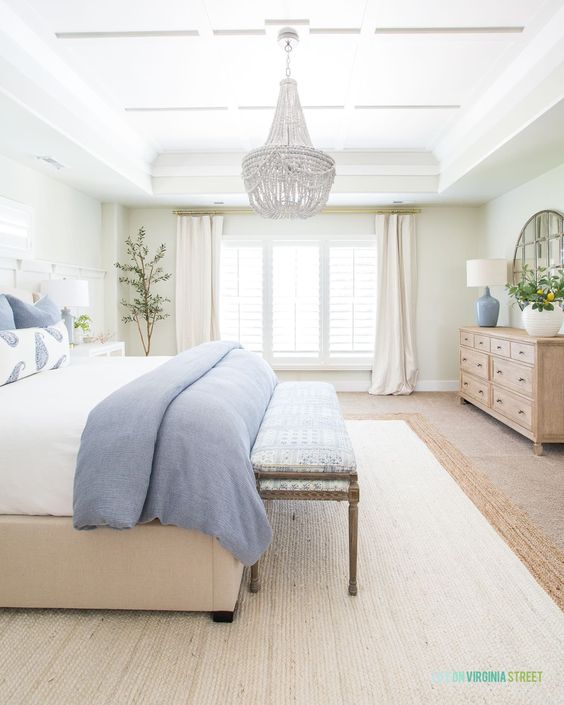
2 – Grey and Blush Pink
The mix of grey and blush pink provides the right balance for creating a classy and peaceful ambiance in your bedroom. Grey provides a tranquil backdrop due to its neutral and versatile character, while blush pink gives a touch of warmth and softness. These colors, when combined, create a harmonious and beautiful environment that can transform your bedroom into a tranquil haven.
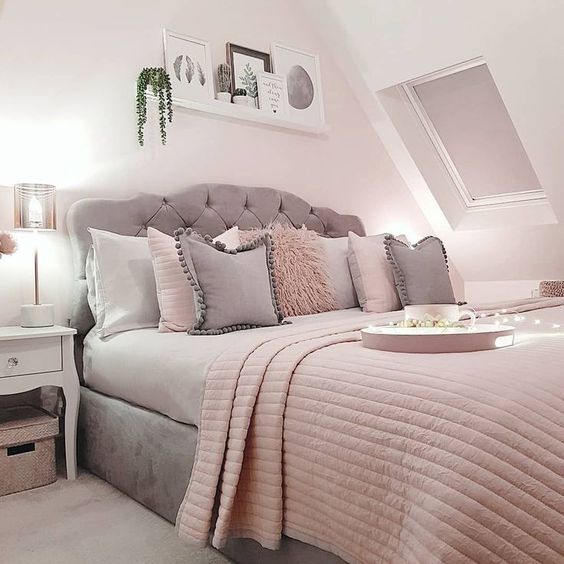
3 – Earthy Neutrals
Earthy neutrals include warm and muted tones like beige, taupe, brown, and grey. These colors have a calming and anchoring influence in the bedroom. Consider colors that imply natural characteristics, such as sandy beige for a desert, mossy green for a forest, or stone grey for a rocky setting. Experiment with numerous color combinations to find the one best suits your unique style and desired ambiance.
Layering various neutral colors gives depth and visual appeal to your bedroom. To create a warm and tranquil backdrop, start with a neutral foundation color for the walls, such as a soft beige or warm grey. Complementary neutral colors should be used in fabrics, furniture, and accessories. To generate contrast and balance in the room, combine lighter and darker tones. Layering adds richness and dimension to your environment while maintaining a unified and harmonious appearance.
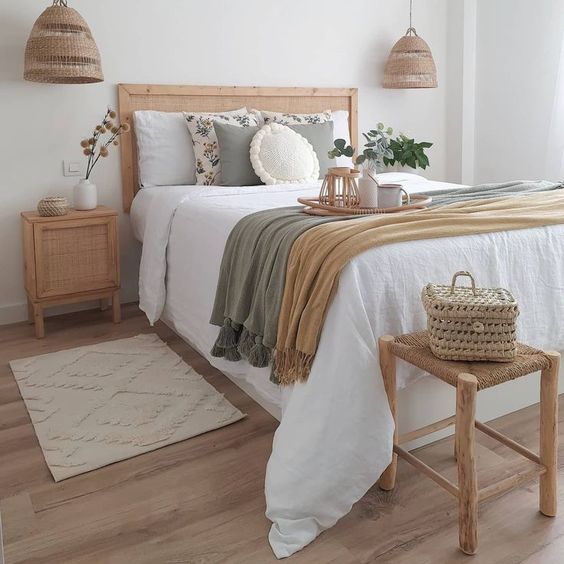
4 – Classic Black and White
Few color combinations in the bedroom can equal traditional black and white’s timeless elegance and sophistication. This iconic pair adds a feeling of balance, contrast, and simplicity to any area, resulting in a clean and stylish look. Whether you like a modern and minimalist aesthetic or a more traditional and opulent vibe, the black and white color palette offers a versatile canvas for transforming your bedroom into a stylish sanctuary.
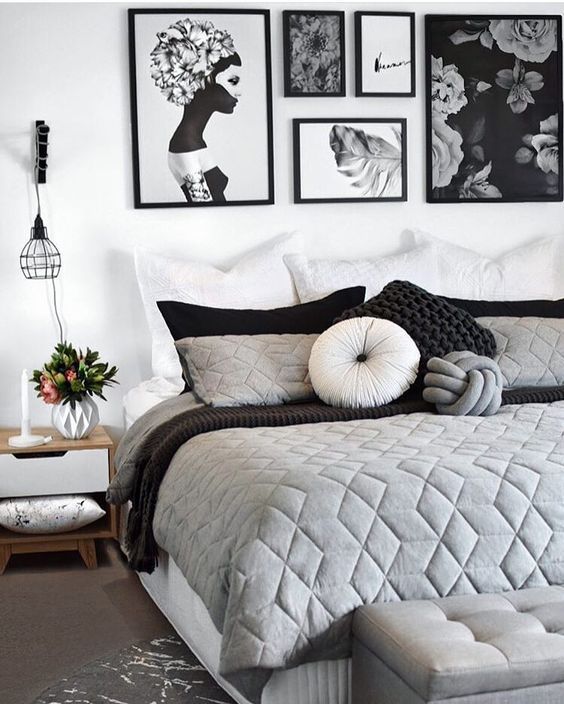
5 – Lavender and Mint
The combination of lavender and mint is a fantastic choice for infusing your bedroom with a sense of tranquility and playfulness. Lavender’s calming and soothing capabilities complement mint green’s refreshing and renewing attributes well. This color scheme produces a dreamy, ethereal atmosphere that encourages relaxation and tranquility.
Choose lavender hues that are gentle and understated with lilac or dusty purple undertone. These gentle colors provide a sense of calm and femininity in the atmosphere. Choose a delicate and pastel mint green that gives the sensation of new spring foliage. Aim for a balance of the two colors so that they complement each other beautifully.
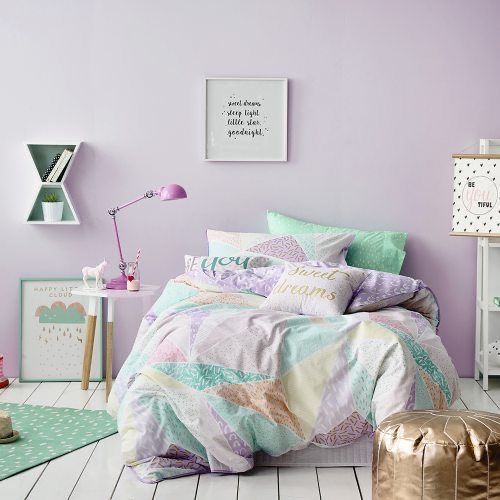
6 – Navy Blue and Gold
Look no further than navy blue and gold for a bedroom color combination that emanates elegance, refinement, and a hint of wealth. The deep, rich navy blue and warm, dazzling gold tones create a sumptuous and timeless atmosphere. Whether you like a conventional, modern, or eclectic style, Navy blue and gold may take your bedroom décor to new heights.

7 – Coral and Turquoise
Choosing the proper tones of coral and turquoise is critical when adding them to your bedroom. To create a bright and energetic ambiance, choose coral hues that are bold and saturated, such as salmon or deep coral. Choose a vibrant and dramatic hue of turquoise to add a splash of color to the room. Aim for a cohesive and eye-catching palette by balancing the two colors.
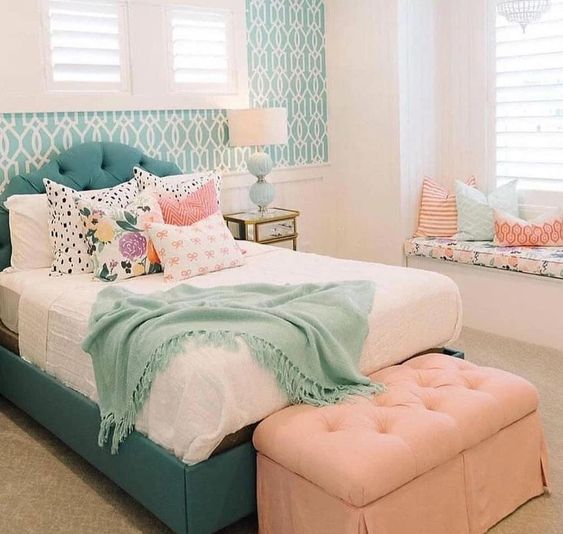
8 – Muted Pastels
Choose a color scheme that is consistent and harmonious when introducing muted pastels into your bedroom. Consider delicate mint green, dusty pink, mild lavender, or light blue pastels. These muted colors provide a soft and tranquil impact, allowing the colors to mix easily and elicit a peaceful ambiance. Choose a few key pastel colors that speak to you and base your color scheme on them.
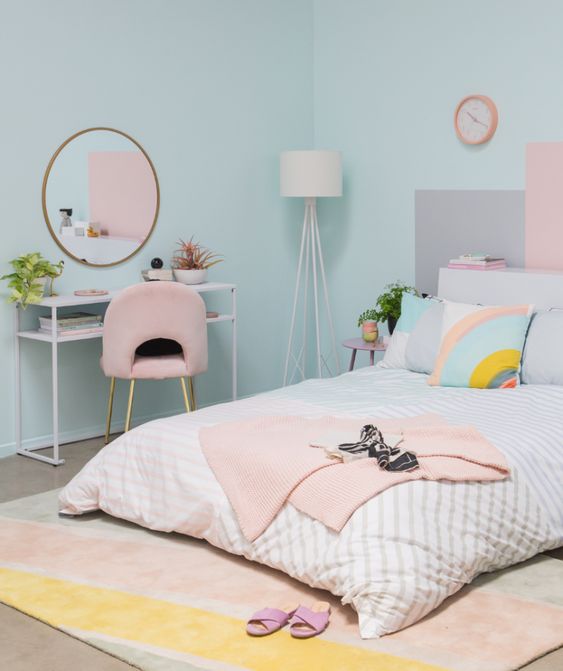
9 – Warm Terracotta and Cream
Begin by making warm terracotta the focal point of your bedroom. To make a big statement, consider painting an accent wall with terracotta. Alternatively, terracotta can be introduced through textiles such as curtains, beds, or throw cushions. Terracotta can also be used in furniture, such as a comfortable armchair or a stylish terracotta vase. These rich color anchors the space and offers warmth and earthiness.
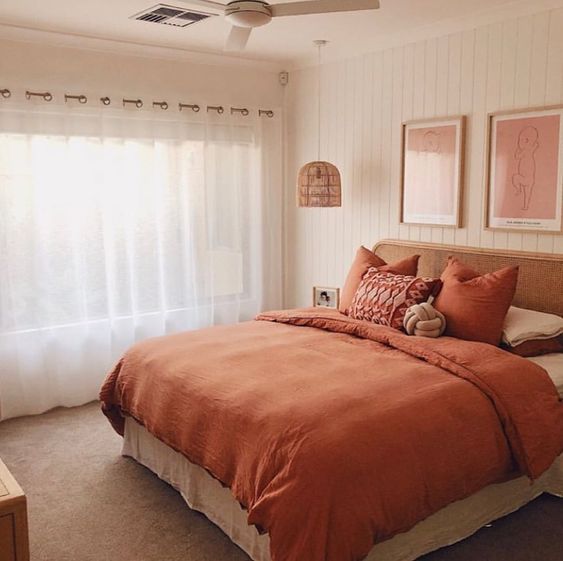
10 – Bold Red and Charcoal Gray
The combination of red and charcoal grey is ideal for making a big statement in your bedroom while creating a contemporary and stylish atmosphere. The intense red vibrancy, combined with the depth and richness of charcoal grey, produces a stunning contrast that adds drama and modernism to your room.
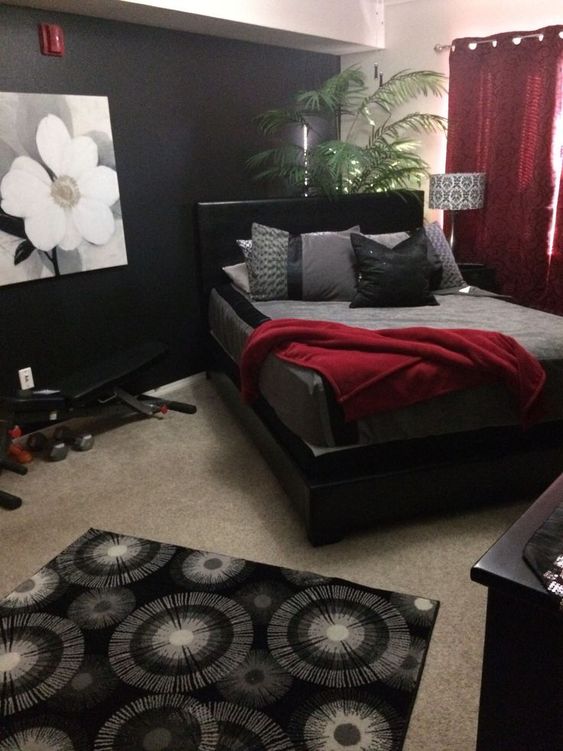
11 – Teal and Mustard Yellow
Teal and mustard yellow are complementary colors because they are opposite each other on the color wheel. This implies that they generate a great contrast when utilized together, resulting in an intense and dramatic visual impression.
Teal is a chilly color, while mustard yellow is a warm color. Combining warm and cold tones in a bedroom can create a harmonious and appealing atmosphere. The warm mustard yellow creates a cozy and inviting atmosphere, while the incredible teal is refreshing and peaceful.
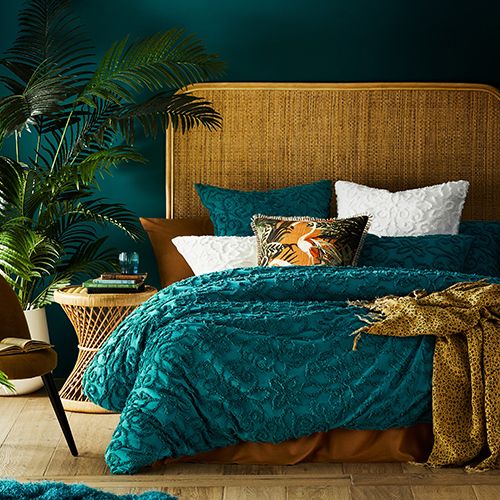
12 – Mint Green and Coral
Selecting the proper mint green and coral tones is critical when adding them to your bedroom. Choose delicate, subtle colors of mint green that inspire a sense of calm and nature. Consider pastel mint or seafoam green for a calm and pleasant environment.
Choose a vivid and lively hue of coral to add a pop of energy to the space. Aim for a balance between the two colors, allowing them to complement each other while generating a visually pleasant and harmonious palette.
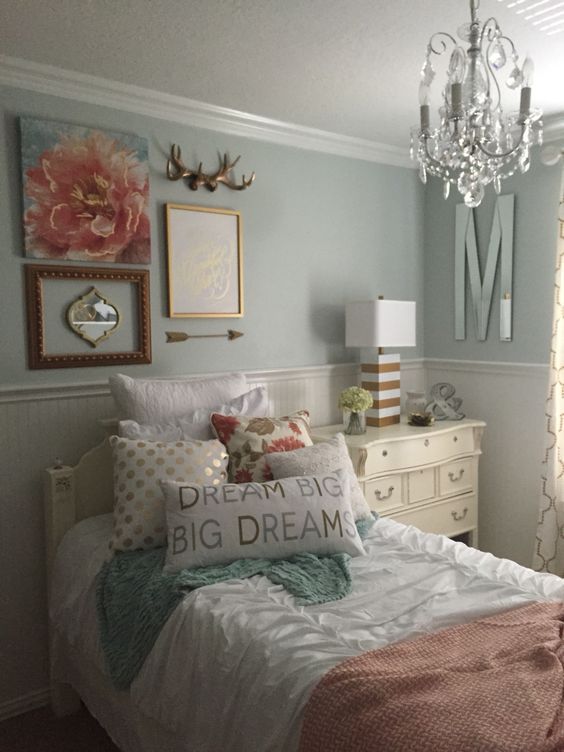
13 – Moody Purple and Dark Gray
Dark grey is peaceful and quiet, although purple is frequently connected with relaxation and tranquility. These colors, when combined, can create a quiet and pleasant ambiance in your bedroom, making it an ideal place for rest and relaxation.
Purple comes in a variety of colors, from rich and saturated tones to lighter pastel tones. This adaptability allows you to customize the ambiance of your bedroom to your liking. Dark grey is a versatile backdrop that works well with many tones of purple and complements a variety of décor types.
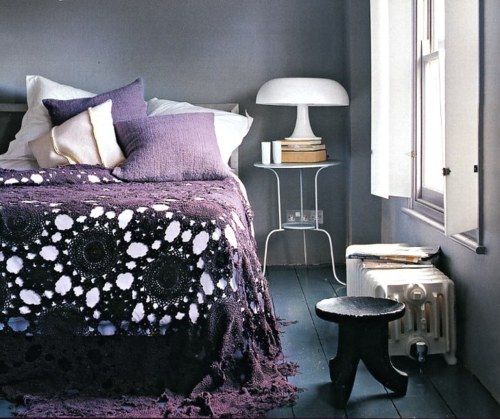
14 – Dusty Rose and Sage Green
Sage green is frequently connected with nature, evoking lush vegetation and fresh greenery. Dusty rose, on the other hand, has the ability to suggest the delicate colors of flowers. This combination brings a hint of nature into your bedroom, providing a natural and organic atmosphere.
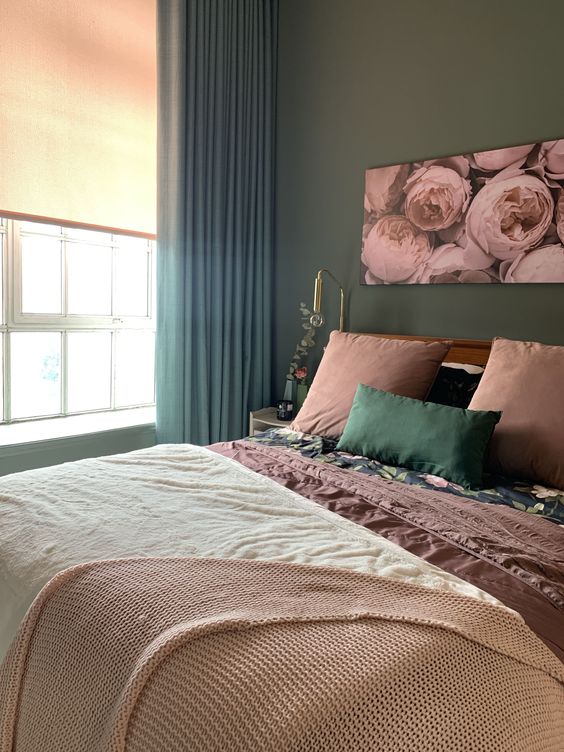
15 – Soft Peach and Creamy White
Peach and creamy white are flexible colors that can complement a variety of styles and themes. They may compliment various accent colors and patterns, allowing you to tailor your bedroom to your tastes and preferences.
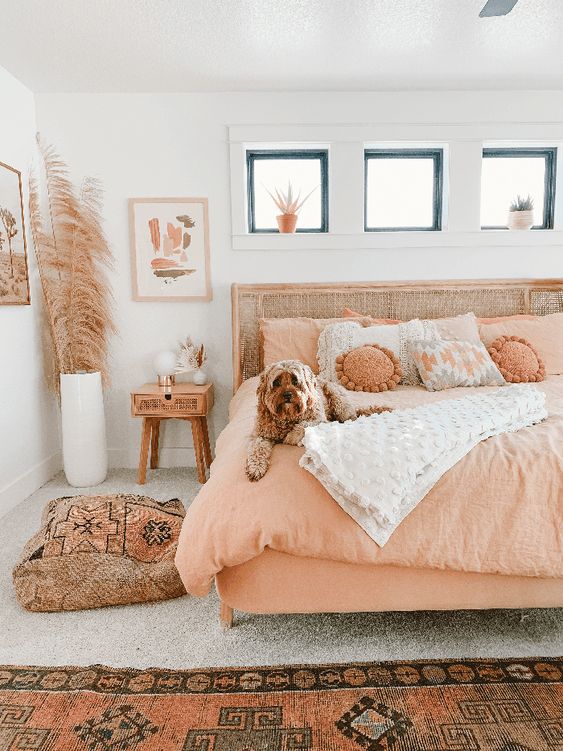
16 – Monochromatic Grays
Grey is a timeless and traditional color that can add sophistication and elegance to any area. Using different colors and tones of grey in a monochromatic palette gives your bedroom a unified and finished look.
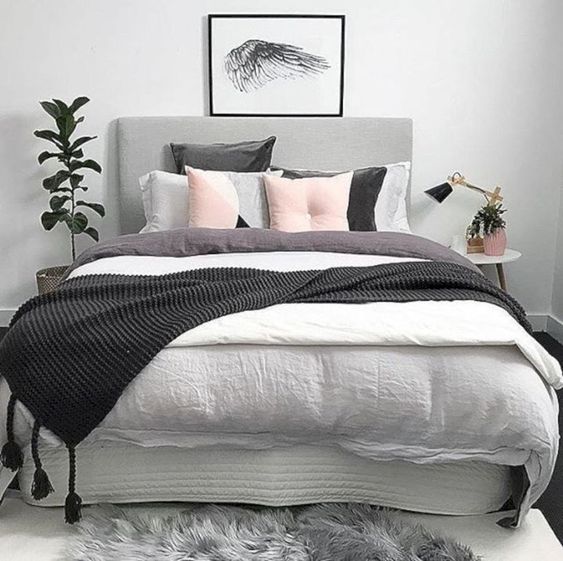
Create Your Dream Bedroom According To Your Aesthetics
Tranquil Tropics
Combining teal, turquoise, and seafoam green will transport you to a tropical paradise. These cool colors create a calm and pleasant atmosphere reminiscent of the sea. Pair this hue with natural textures like bamboo or rattan furniture and leafy green plants to complete the tropical island vibe.


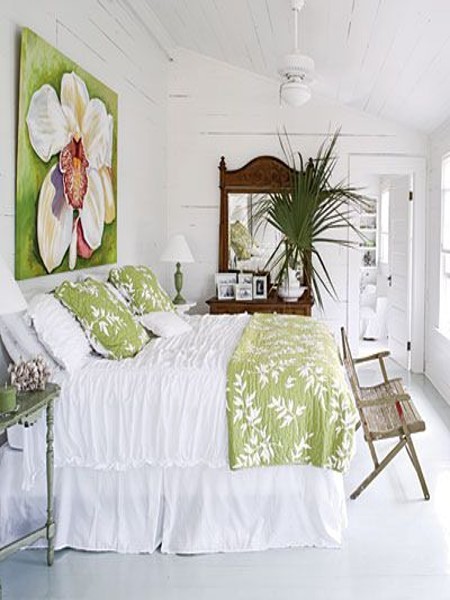
Bohemian Dream
Blend warm earth tones with vivid bursts of jewel tones to evoke a bohemian vibe. Combine sandy browns, terracotta, and mustard yellows with deep purples, blues, and greens. This eclectic blend gives your bedroom a feeling of adventure and ethnic flair. To accentuate the bohemian look, incorporate ethnic patterns, tapestries, and ornamental elements from many civilizations.
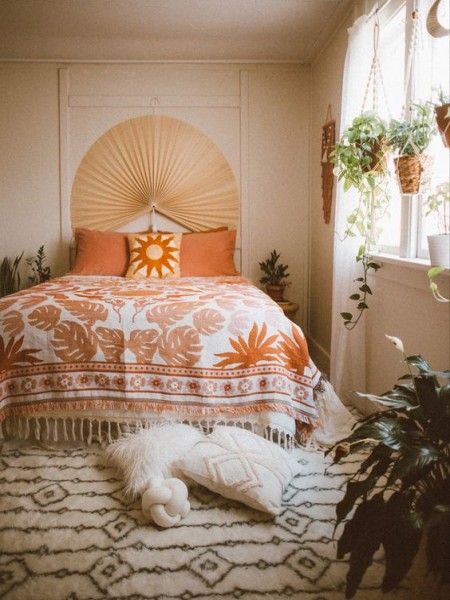
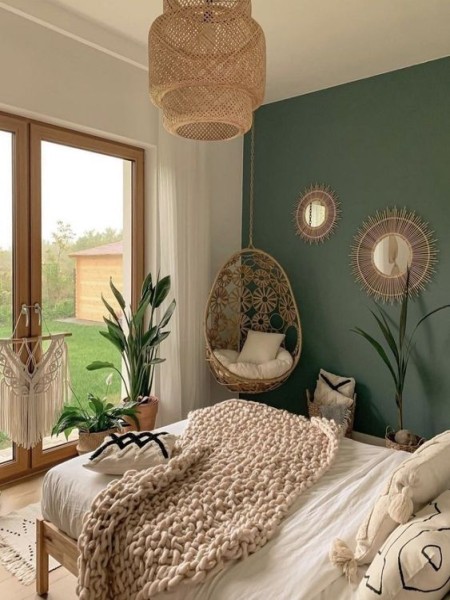
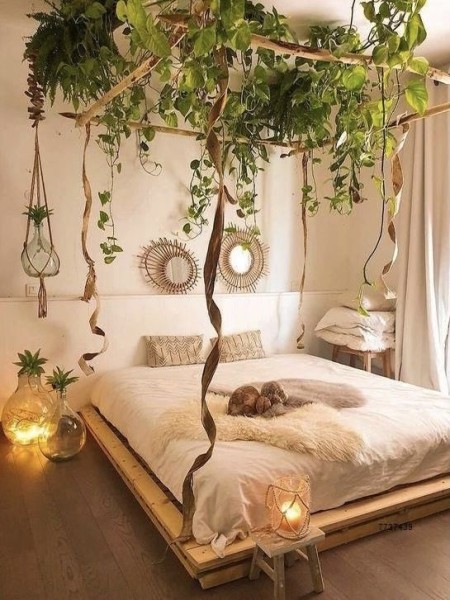
Scandinavian Chic
Choose a Scandinavian-inspired color scheme for a clean and simple aesthetic. Crisp whites should be combined with soft greys, light blues, or blush pinks. This color scheme promotes calm and simplicity while allowing natural light to shine through. Light-colored wooden furniture, cozy linens, and simple design will add to the Scandinavian vibe.
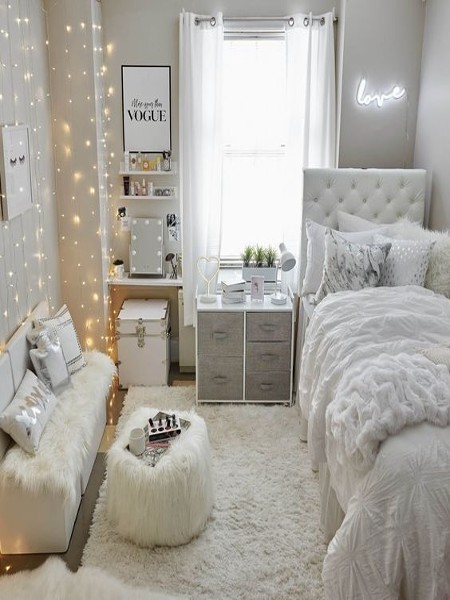
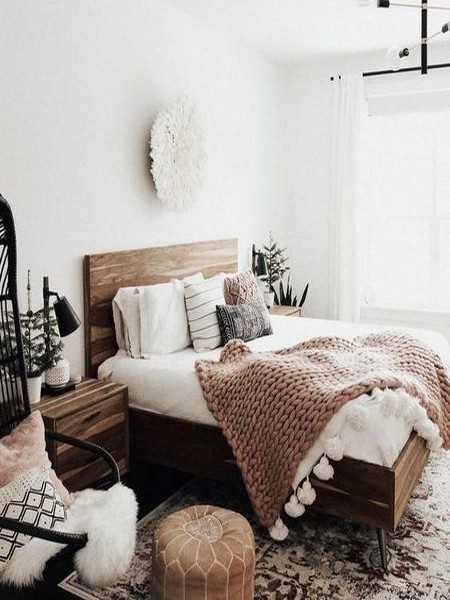
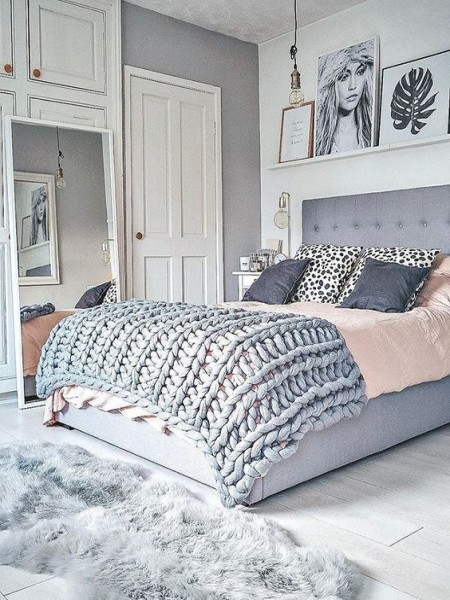
Moody Elegance
Use a dark and ominous color scheme to channel your inner drama queen. Deep blues, charcoal greys, and rich purples create a refined and private atmosphere. Metallic gold or silver accents might give a bit of glam to this somber setting. To create a genuinely sumptuous setting, balance the darkness with ambient lighting, rich textures, and luxurious textiles.
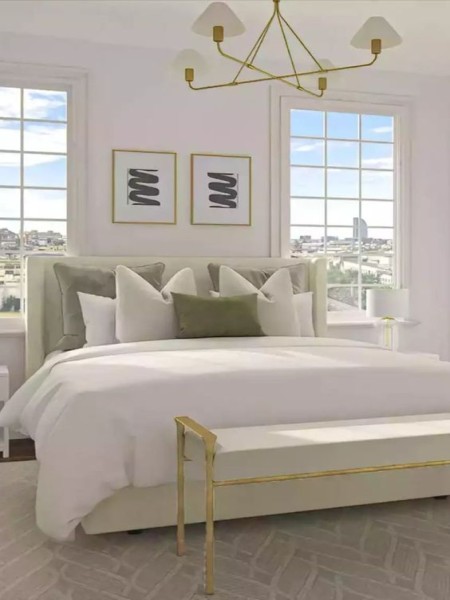
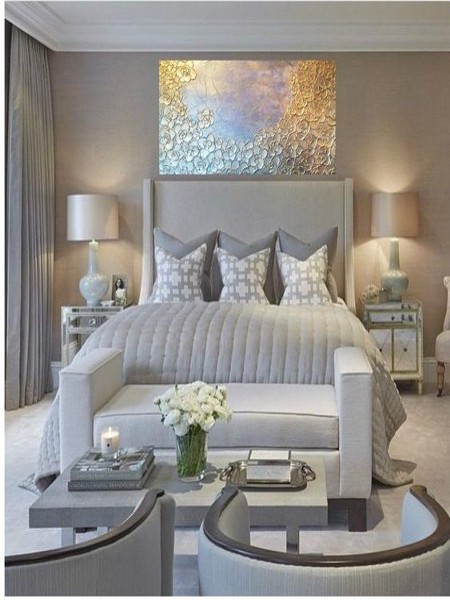
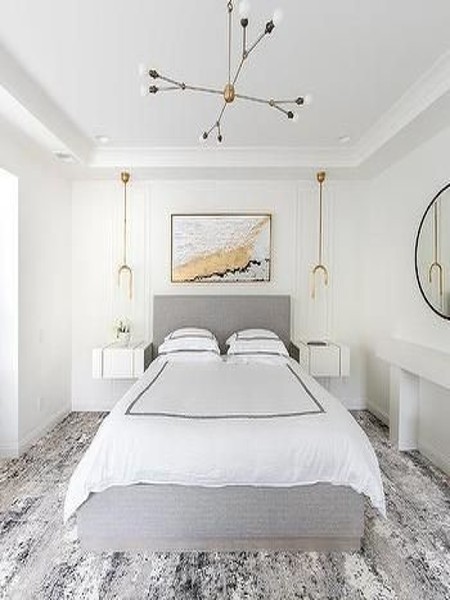
Serene Serendipity
This palette contains delicate pastels and subtle colors inspired by the soothing hues of dawn and sunset. Combine delicate pinks, lilacs, sky blues, and mint greens to create a peaceful and ethereal atmosphere. Add traces of white or ivory to highlight the dreamy aspect of this color scheme. Add sheer curtains, fluffy carpets, and delicate decorations to complete the tranquillity.
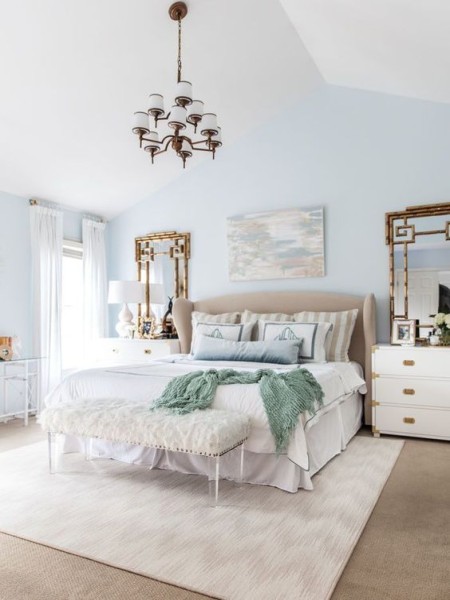
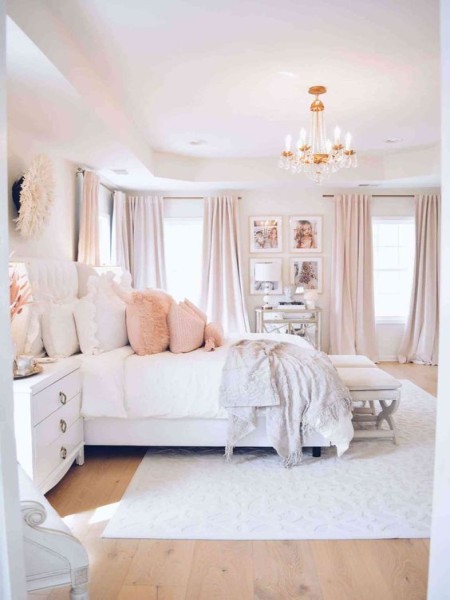
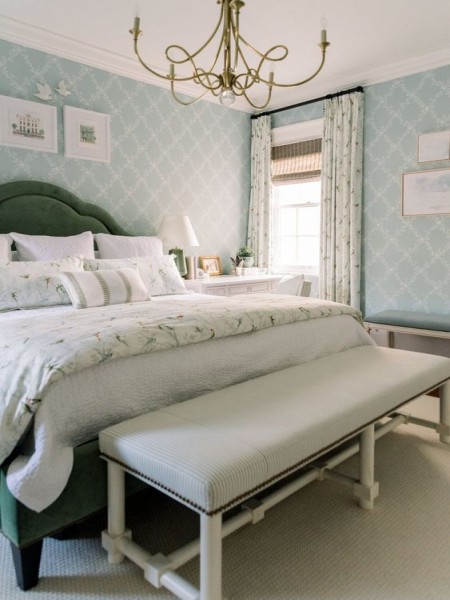
Urban Oasis
With an urban-inspired color palette, you can embrace the vitality of the metropolis. Combine industrial greys, metallic accents, and bright colors like neon yellows and electric blues. This dynamic combination provides a modern and edgy atmosphere. To convey the sense of city living, incorporate urban-inspired artwork, geometric patterns, and streamlined furnishings.
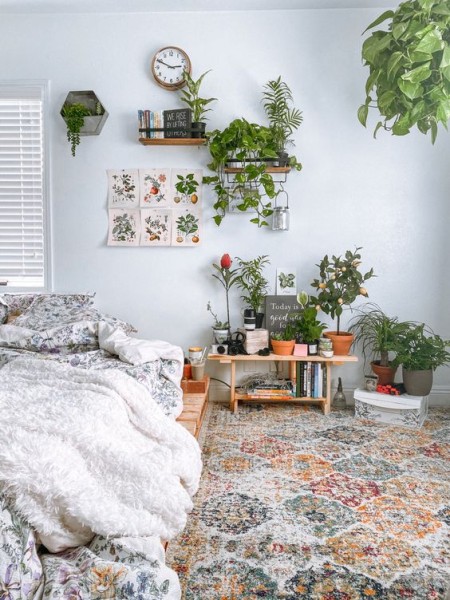
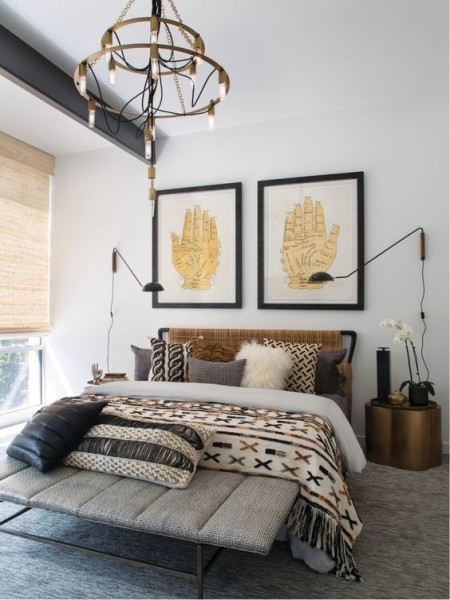
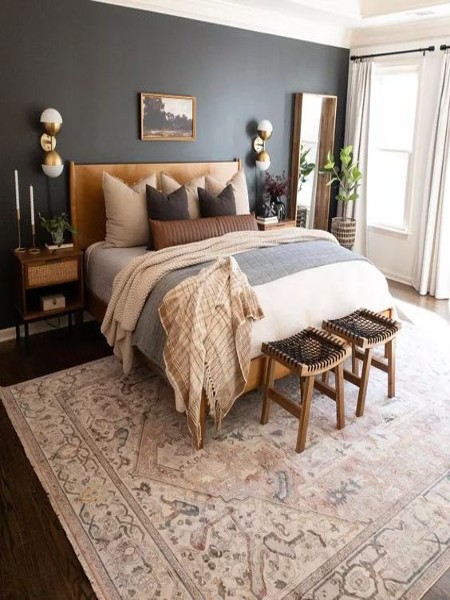
Tips To Consider Before Making Your Final Decision
There are various elements to consider when selecting a color for your bedroom, including personal choice, mood, and the overall aesthetic you wish to achieve. Here are some pointers to consider while selecting a bedroom color:
1. Consider your personal preference:
Because your bedroom is your personal sanctuary, choose a color that you adore and feel at ease with. Consider colors that make you feel at ease, serene, and cheerful.
2. Determine the mood you want to create:
Different colors elicit various feelings and emotions. Consider cold and muted colors like blues, greens, and greys for a quiet and peaceful atmosphere. Warm colors such as reds, oranges, and yellows can help to create a cozy and inviting atmosphere.
3. Take into account the size of your bedroom:
Colors can influence how big a room appears to be. Lighter colors make a room feel more open and airy, while darker colors create a more personal and cocoon-like environment. If you have a small bedroom, choose lighter colors to make it appear larger.
4. Consider the amount of natural light:
Natural light can significantly influence the look of colors in a room. If your bedroom has plenty of natural light, you can try bolder and brighter colors. If the room lacks natural light, select brighter colors to keep it from seeming too dreary.
5. Harmonize with the existing decor:
Examine your bedroom’s furniture, flooring, decoration items, and other aspects. Consider how your chosen color will complement or contrast with these existing pieces. If you have boldly patterned or colored furniture or accessories, a neutral or light color on the walls can help balance the entire effect.
6. Consider the purpose of your bedroom:
Think about how you use your bedroom the most. Soothing colors, such as light blues or greens, might be beneficial to sleep in a rest and relaxation situation. If you use your bedroom as a workspace or for other activities, colors that stimulate focus and creativity may be acceptable.
7. Test samples before committing:
Testing out the colors you’re considering before painting the entire space is a good idea. Paint small patches on several walls and watch how they appear at different times of day and under different lighting situations. This can help you visualize how the color will appear in your environment.
Remember that color is a subjective concept with no hard and fast guidelines. Finally, select a color that speaks to you and provides the ambiance you want in your bedroom.
Conclusion
Your bedroom is your personal sanctuary, and the colors you choose can significantly impact the space’s environment and mood. You may create a really personalized and inviting environment by researching unique bedroom color ideas and mixing and matching different palettes. Whether you get your inspiration from nature, culture, or current design trends, the goal is to experiment with colors that suit your personal style and tastes. With these inventive ideas at your disposal, you can take your bedroom to new heights of aesthetic appeal and transform it into a space that genuinely expresses your personality. So channel your inner artist and turn your bedroom into a colorful haven of comfort!



